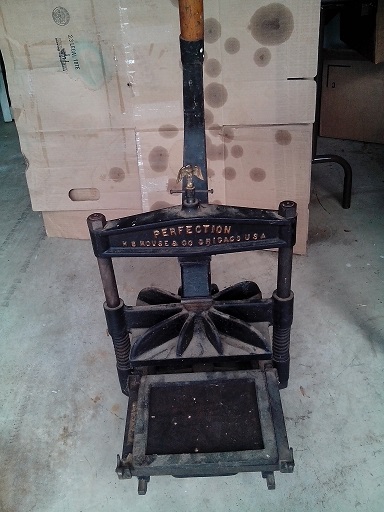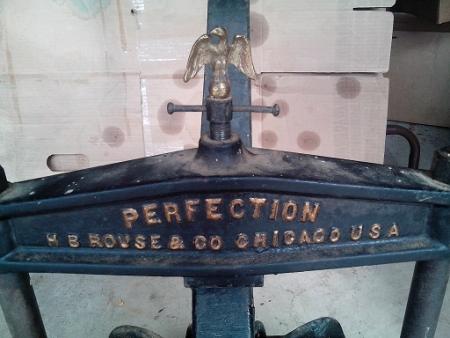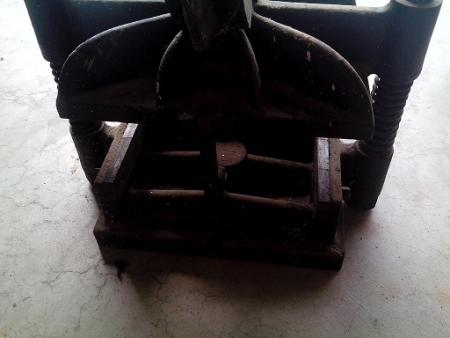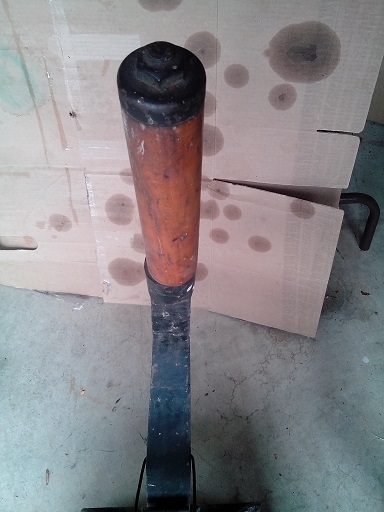H.B. Rouse Press - any photos or illustrations out there?
I was helping a friend with a etching press acquisition on Saturday, and ended up with some additional interesting items. One was what at first looked like a book press or copy press, but has a chase and platen that slides into place on rails. It is marked as a H.B. Rouse & Co. Chicago USA and at the top PERFECTION. The number 407 is cast into several of the parts, too. I did some extensive searches, but haven’t located much information. I don’t know if I even have all the parts. Would love to know more.

Rouse1.jpg

rouse2.jpg

rouse3.jpg

rouse4.jpg

rouse5.jpg
It looks to me to be the first version of the Rouse Proofing Press. I could never find a photo of one, but owned the second version for a while. I don’t think that the chase or the eagle are original, and it would be nice to see a picture taken from the side to see the impression mechanism.
Paul
I had not seen this version, which I think Paul correctly assesses as an earlier version. It is my belief that it was originally made by Rouse for the purpose of taking the wax impression from a type forme or plate, for the matrix of an electrotype, using the early technology of a wax matrix which was later (don’t know when) replaced by thermally-molded plastic. It would be nice to find a Rouse publication, preferably a catalog, that describes these presses, for confirmation of their intended use.
The toggle is a simple “knee” joint with the bar attached to the upper link, being pulled down to straighten the knee and apply pressure. I think it’s possible the eagle is original, and the chase may be as well, if it was meant to be used with the blocks on the sides against the corner irons, one of which is missing.
I have recorded several of the later models and would like to add this one to the North American Hand Press Database, if I can get additional information about Franklin Creations.
Bob
Actually, I see the numbers 403 and 404 on parts as well. Had to improvise the knee joint, but it works
image.jpg
image.jpg
image.jpg
Great information! Thanks. As I was cleaning the press today, discovered the number 401 on the base, too. I measured the movement of the upper platen down to the lower platen. It only moves from a 1 5/8th inch clearance to 1 5/16th. Also I agree this chase isn’t original, the lower platen has different proportions. It could accommodate a chase with outside measurements of 8 1/2 by 12 inches.
From my file on H. B. Rouse presses here is a Xerox copy from an older Ostrander Seymour catalogue than the one I have. It appears that your press is an even older version of the one shown below. Ralph Green states that the Rouse Company first offered these presses in 1912, so I think it would be safe to say that it dates from about that time.
I don’t think that the impression handle is attached correctly. From the acute angle shown in your picture I think the assembly is upside down. Obviously you will need to get a steel pin made that will fit the missing hinge. Setting it up right will certainly increase the clearance between the bed and platen. The mechanism would have been designed to go on impression by pushing the handle down, rather than pulling up as it is currently set up. The impression handle may well sit on the opposite side of the press, above the extended bed, and might raise up enough for the tympan to clear.
The press most certainly did not come with the funky little eagle on it, it looks like one that would have been found on a cheap banjo clock or barometer. Rouse did not decorate their machines. The chase would have filled the bed, and was welded steel rather than the cast chase that it currently has. It would have had a tympan with no frisket, as they were not intended as production printing machines. On the press I owned the tympan opened against the press staple, rather than at the end like a conventional hand-press.
They were sold simply as proofing presses for engravers, and could not have been used to make wax moulds for electrotyping, as for that process the wax had to be heated to soften the wax.
RouseProofPress_1.JPG
Should you want a reference for the xerox copy cited on DTP’s post of the #1 press, I located it in my “Ostrander Seymour Catalog No. 20”; dated 1916. Illustration as above is on pg 210. A general description for this proof press and it’s use is in the section heading “Everything for the Stereotyper” on pg 211. Also illustrated and mentioned is the press’s near twin (#2) which has a larger bed size of 14” x 17”.
Depending on where you live, WorldCat lists some older Ostrander Seymour catalogs in the holdings of a couple libraries back east: 1912 & 1914 editions at Columbia Univ Library (NYC) & 1902 & 1908 editions at the Univ of Deleware Library (Newark). Those editions are listed as containing electrotyping equipment and may include an illustration of your proof press.
Not sure how Ostrander Seymour created 20 catalogs by 1916 as so few are ever listed and there always seem to be a gap of years between each edition.
Ostrander Seymour catalogues are kind of like booksellers’s catalogues, you just have to guess when they are issued. I have O.S. catalogue No. 21 and there is no indication as to when it was issued except for the the pencilled notation on the title page, (1923?). It no longer lists the Rouse proof presses, whether they are no longer made or fallen out of favor is something to wonder over. I have a letter from H. B. Rouse, and they give the making dates from 1918 to 1923, but I also have the industry announcement for the larger press they offered in a March 1915 Inland Printer. So there you go.
Paul, like you, I assume my OS catalog #21 is from 1923(?), as no printing date is listed. On the other hand, my #20 catalog has the 1916 date clearly printed on the title page. I’ve never viewed any of their earlier catalogs. Always found their catalogs interesting as they included large illustrations of specialized equipment and tools seldom found in other printers’ catalogs. The #21 catalog contents are a “big” departure from the #20 as it expands into more photo-chemical processes, cameras, and engraving.
A Rouse brochure that I have lists their business as having started in 1899, so it appears that the press in question may have been manufactured somewhere in the window between 1900-1915.
Ralph Green who combed through industry publications and existing records when he assembled his book on hand-presses, stated that the Perfection Proof Press was first offered in 1912. If anyone cares to look through the Inland Printer of that year they might very well come up with a better reference date.
I’m posting two drawings of a press invented by Harold Smith of Sacramento, CA in the 1970s. The Har-Ma Press had refinements that were not available on any other hand-press, but the way the bar is attached makes me think that your press might have been set-up somewhat similarly. The top drawing might give you some ideas about how to attach a frisket to the non-existent tympan.
HarMaPress_2.jpg
HarMaPress1980.JPG
Great Information everyone! Thanks for the education. Dating it to almost 100 years ago is exciting. I will look at additional ways to situate the handle based on this photo. There is a little notch in the back of the handle that doesn’t seem to line up with anything, and a wire bracket attached on the back side of the upper section of the press, which fits pretty well with the angle at which I initially set up the handle. I’ll move it up and see if it will works.
Looking again at the configuration of the handle and press, and given that it appears to have been intended to be used on a bench-top rather than the integral stand of the later models, I think your initial assembly is correct, with the handle being pushed up and in for impression. I don’t think it will clear the bed and platen if reversed. The heavy wire bale is to prevent too much excursion of the bar which would cause the toggle to come apart. But try reversing it to see how it fits — I could be wrong! (Wouldn’t be the first time.)
Bob
I can see why they quickly changed the design of the impression knuckle.
Also, I suggest that since the bolt you have used for one of the pivots seems to be the right size I would cut it off to length plus a little, without the head or threads. If you work the press much with the bolt as positioned its threads will damage the bearings of the toggle.
Bob
You need a pivot that is not a bolt. Do it right, not just make-do. Most bolts are made in China of less than desirable steel have a coating to prevent rusting that would be abrasive over time. Get the right piece made of stainless steel.
For a straight Axis Bolt Shaft Etc. Etc. (hopefully and possibly the same Stateside??) …Merely purchase small length of *EN1A* machine-able steel rod, perfectly able to be cut with conventional hacksaw, hence machine-able.!
No need to Drill and Tap OR thread, to secure, just purchase small pack of “DISHED” steel washers, I.E. the fingers are like Crocs teeth, they face backwards, push on 100% secure. can be removed with Nose pliers, if ever needed.
Plus being good old Yankee ROUSE will invariably be Imperial size fittings 3/8” 1/2” 5/8” etc. etc.
I was able to get the original pin to replace the temporary bolt, so it is functioning as it should with all the right pieces now.
Well, this Rouse Press is kind of getting in the way in my garage and I really don’t have any need for it, or any plans for it. If anyone would be interested in it—please contact me directly. I don’t think shipping would be a good idea, as it is very heavy and the handle is very long.
I made a pretty good test print on this Rouse Proof Press as I prepped it to be picked up by the new owner. It wouldn’t be fast, but it gives a nice even impression.
Found it listed in the Inland Printer 1912 - page 752
https://books.google.com/books?id=zW0eAQAAMAAJ&printsec=frontcover&sourc...
Inland Printer Rouse Perfection 752b.jpg
Inland Printer Rouse Perfection 752d.jpg